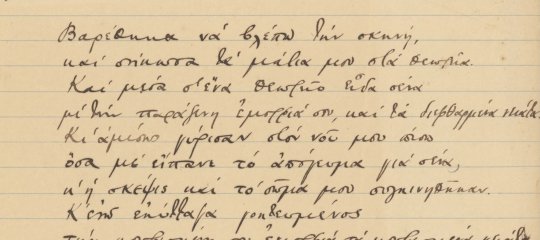Friedrich-Alexander-Universität Erlangen-Nürnberg
Συμεώνα Σαράτση
Αγαπητοί συνάδελφοι,
το Κέντρο Γλωσσών (Sprachenzentrum), όπου εργάζομαι, αποτελεί ιδιάιτερο τμήμα του Πανεπιστημίου Ερλάνγκεν-Νυρεμβέργης (Friedrich-Alexander-Universität Erlangen-Nürnberg). Προσφέρει σε φοιτητές όλων των σχολών του Πανεπιστημίου καθώς και σε απλούς ακροατές τη δυνατότητα εκμάθησης ενός ευρύτατου φάσματος γλωσσών (από αγγλικά και γερμανικά έως αραβικά, κινεζικά, σουαχίλι, κ.λπ.). Οι γλώσσες αυτές δεν συνδέονται απαραίτητα με κάποια ανάλογη πανεπιστημιακή εδρα. Στην κατηγορία αυτή ανήκουν και τα νέα ελληνικά.
11 Ιουνίου 2009
Βέβαια, ενώ δεν υπάρχει έδρα νεοελληνικών σπουδών, για τα νέα ελληνικά δείχνουν ενδιαφέρον κυρίως όσοι φοιτούν σε σχολές, των οποίων τα αντικείμενα σχετίζονται άμεσα με τον ελληνικό πολιτισμό, όπως κλασική φιλολογία, αρχαιολογία, ιστορία, θεολογία. Επίσης, μαθήματα νέας ελληνικής γλώσσας παρακολουθούν και ακροατές, οι οποίοι έχουν αναπτύξει φιλικές σχέσεις με Έλληνες, επισκέπτονται συχνά την Ελλάδα ή υπάρχει γι’ αυτούς προοπτική εγκατάστασης στη χώρα, καθώς και κάποιοι που επιθυμούν μια αμεσότερη γνωριμία με την ελληνική λογοτεχνία και τον ελληνικό πολιτισμό.
Στο Κέντρο Γλωσσών τα μαθήματα είναι οργανωμένα για όλες τις γλώσσες με συγκεκριμένο τρόπο και σε αρκετές από αυτές προσφέρονται σε τέσσερα επίπεδα (επίπεδο αρχαρίων έως Β1, Β2, Γ1 και Γ2 κατά την κλίμακα του Κοινού Ευρωπαϊκού Πλαισίου Αναφοράς του Συμβουλίου της Ευρώπης - ΚΕΠ). Τα νέα ελληνικά προσφέρονται στα δύο πρώτα επίπεδα με τη μορφή κανονικών αλλά και ταχύρρυθμων τμημάτων. Το Κέντρο Γλωσσών διαθέτει και γλωσσικό εργαστήριο, εξοπλισμένο με σύγχρονα οπτικοακουστικά μέσα, όπου η παρουσία της ελληνικής γλώσσας είναι μάλλον μικρή, αλλά γίνεται προσπάθεια για την ενίσχυσή της.
Τέλος, το Κέντρο Γλωσσών αποτελεί και εξεταστικό κέντρο για το πτυχίο UNIcert, που περιλαμβάνει τέσσερα επίπεδα (I, II, III και IV αντίστοιχα των επιπέδων Β1, Β2, Γ1 και Γ2 της κλίμακας ΚΕΠ). Στα νέα ελληνικά γίνονται εξετάσεις για τα πτυχία UNIcert Ι και ΙΙ. Οι εξετάσεις είναι γραπτές (κατανόηση και παραγωγή γραπτού λόγου, κατανόηση προφορικού λόγου) και προφορικές και γίνονται πάντα από δύο εξεταστές. Επιδιώκεται, ωστόσο, και η γνωριμία των ενδιαφερομένων με το Πιστοποιητικό Ελληνομάθειας.
Με εκτίμηση,
Συμεώνα Σαράτση
- Εισέλθετε στο σύστημα για να υποβάλετε σχόλια











